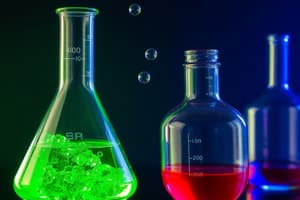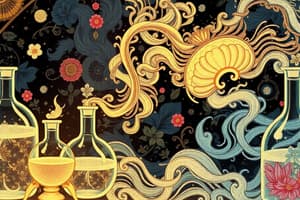Podcast
Questions and Answers
Which of the following is an example of a physical change?
Which of the following is an example of a physical change?
- Cooking an egg
- Rusting iron
- Bending a metal rod (correct)
- Burning wood
In a chemical change, the identity of the matter remains the same.
In a chemical change, the identity of the matter remains the same.
False (B)
What is the process called in which new substances are formed during a chemical change?
What is the process called in which new substances are formed during a chemical change?
chemical reaction
The principle stating that the total mass of matter remains the same during physical or chemical changes is known as ______.
The principle stating that the total mass of matter remains the same during physical or chemical changes is known as ______.
Match the following changes with their correct classification:
Match the following changes with their correct classification:
Most matter __________ when temperature increases and __________ when temperature decreases.
Most matter __________ when temperature increases and __________ when temperature decreases.
Water contracts when it freezes.
Water contracts when it freezes.
Why do bridges have expansion joints?
Why do bridges have expansion joints?
The rate at which physical changes occur is often affected by ______.
The rate at which physical changes occur is often affected by ______.
Match the following scenarios with the effect of temperature on the process.
Match the following scenarios with the effect of temperature on the process.
What happens to the total mass during a chemical change?
What happens to the total mass during a chemical change?
When wood burns, the mass of the wood equals the mass of the ashes produced.
When wood burns, the mass of the wood equals the mass of the ashes produced.
In a sealed flask, if a chemical reaction occurs, how does the final mass compare to the starting mass?
In a sealed flask, if a chemical reaction occurs, how does the final mass compare to the starting mass?
Increasing oven temperature ______ the rate of chemical changes that occur when a cake bakes.
Increasing oven temperature ______ the rate of chemical changes that occur when a cake bakes.
Match the following temperature effects with the appropriate outcome:
Match the following temperature effects with the appropriate outcome:
Why might having a fever be a good thing?
Why might having a fever be a good thing?
A high fever is considered to be above 39°C.
A high fever is considered to be above 39°C.
What is the typical temperature of the human body in degrees Celsius?
What is the typical temperature of the human body in degrees Celsius?
The chemical changes that cause food to spoil are ______ down by keeping the food in the refrigerator.
The chemical changes that cause food to spoil are ______ down by keeping the food in the refrigerator.
Match the following:
Match the following:
Flashcards
What is a physical change?
What is a physical change?
A change that does not alter the identity of a substance.
What is a chemical change?
What is a chemical change?
A change that results in a new substance.
What is a chemical reaction?
What is a chemical reaction?
Process in which new substances form during a chemical change.
What is conservation of matter?
What is conservation of matter?
Signup and view all the flashcards
How does temperature affect volume?
How does temperature affect volume?
Signup and view all the flashcards
What is the rate of change?
What is the rate of change?
Signup and view all the flashcards
How does temperature affect chemical reactions?
How does temperature affect chemical reactions?
Signup and view all the flashcards
What is a fever?
What is a fever?
Signup and view all the flashcards
Study Notes
- Matter has properties and undergoes changes
Classifying Change
- Physical changes do not affect the type of matter, while chemical changes do
- Physical change: When you sharpen a pencil, the wood shavings and graphite bits still remain wood and graphite, respectively
- Chemical change: When wood burns, it changes identity, forming ash and gases with different properties
- Chemical reaction is the process in which new substances are formed during a chemical change
Swelling and Shrinking
- Most matter expands when temperature increases and contracts when it decreases
- Water is an exception, expanding when it freezes, becoming less dense as ice
- Bridges have expansion joints that allow them to expand in hot weather and contract in cold weather without buckling
Temperature
- Temperature can affect matter, as seen when a burner on a stove glows red when really hot.
- Temperature affects the rate of some physical changes, and the rate of chemical changes.
- The rate of change indicates how quickly a change occurs.
- Ice on a lake melts if the air temperature is above 0°C, melting faster if the air temperature is warmer.
- Water condenses more quickly on the outside of a very cold soft drink can than on a cool can.
Adding it Up
- During physical and chemical changes, matter may change its appearance or identity, but the total mass remains the same
- The conservation of mass states that mass is conserved (or "saved") during physical and chemical changes
- The total mass of the particles of water vapor in the air equals the mass of the water that boiled away.
Faster or Slower
- Increasing temperature often speeds up the rate of a chemical change, for example, when baking a cake
- Lowering the temperature slows down the rate of chemical change
- Food stays fresh longer when refrigerated.
Fevers
- Fever: When your temperature rises above your normal body temperature (about 37 °C or 98.6°F)
- A low fever is between 38 °C (100.4°F) and 39°C (102.2°F)
- A high fever is greater than 40 °C (104°F)
- Low fevers help the body fight disease, while high fevers can be dangerous
- The brain increases body temperature to fight certain bacterial infections
- Bacteria cannot survive at higher temperatures.
Studying That Suits You
Use AI to generate personalized quizzes and flashcards to suit your learning preferences.




